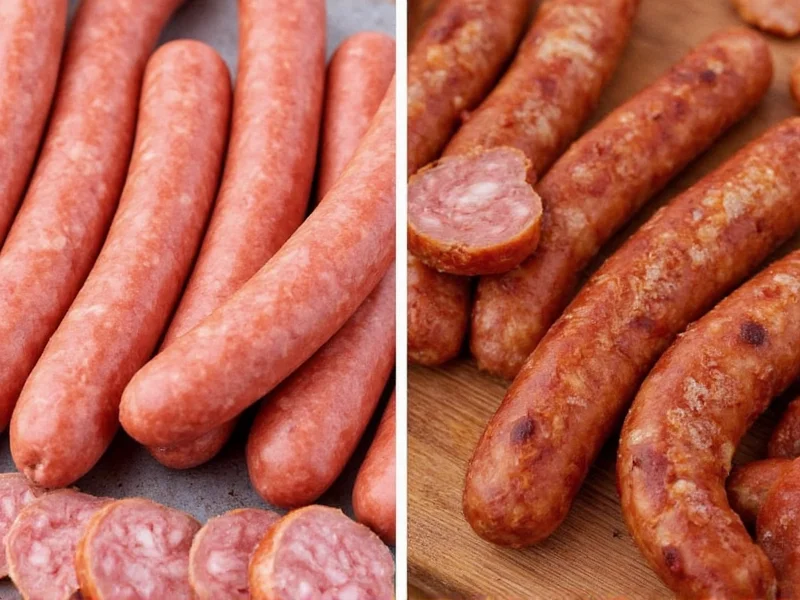Understanding the distinction between kielbasa and smoked sausage matters for both cooking accuracy and cultural appreciation. Many home cooks mistakenly use these terms interchangeably, potentially altering dish outcomes. This comprehensive guide clarifies their differences while highlighting when substitution works and when it doesn't.
What Exactly is Kielbasa?
Kielbasa (pronounced kee-ul-BAH-sa or kel-bahs-uh) originates from Poland, where it's considered a national dish with regional variations across the country. Traditional Polish kielbasa contains coarsely ground pork (sometimes mixed with beef), substantial garlic, marjoram, and smoked over natural wood. Authentic kielbasa often comes packaged in a distinctive U-shape reflecting how butchers traditionally tied the sausage.
American-style kielbasa evolved after Polish immigrants adapted recipes using available ingredients. While still smoked, U.S. versions typically feature finer meat grind, milder seasoning, and sometimes include sodium nitrate as a preservative. Despite these adaptations, garlic remains the signature flavor note that distinguishes kielbasa from other smoked sausages.
Understanding Smoked Sausage as a Category
Smoked sausage serves as an umbrella term for any sausage that undergoes smoking during preparation. This category includes numerous varieties:
- Andouille - Spicy Cajun sausage with pepper flavors
- Bratwurst - German-style often finished with smoking
- Ring bologna - Finely ground smoked sausage
- Breakfast sausage - Sometimes smoked for preservation
- Chorizo - Spanish or Mexican varieties that may be smoked
The smoking process itself varies significantly—some producers use cold smoking (below 85°F/29°C) primarily for flavor, while others employ hot smoking (140-180°F/60-82°C) which fully cooks the sausage. This processing difference affects both texture and how you should handle the sausage in recipes.
| Characteristic | Kielbasa | General Smoked Sausage |
|---|---|---|
| Origin | Poland | Multiple global origins |
| Primary Meat | Pork (sometimes beef) | Pork, beef, poultry, or combinations |
| Signature Flavor | Garlic-forward | Varies by variety (pepper, paprika, herbs) |
| Texture | Coarse grind (traditional) | Finely to coarsely ground |
| Smoking Method | Typically hot smoked | Cold or hot smoked |
| Pre-cooked Status | Usually pre-cooked | Depends on variety |
Key Differences Explained
The most significant difference between kielbasa vs smoked sausage lies in specificity versus generality. Kielbasa represents a particular sausage style with cultural roots, while smoked sausage describes a preparation method applied to many sausage types.
Seasoning profile provides the clearest distinction—traditional kielbasa features prominent garlic with supporting notes of marjoram and pepper. Other smoked sausages might emphasize paprika (like Spanish varieties), cayenne (Cajun styles), or fennel (Italian styles).
Processing methods also differ. Authentic Polish kielbasa uses natural casings and traditional smoking techniques, while commercial smoked sausages might use cellulose casings and liquid smoke flavoring. These production differences affect both texture and flavor complexity.
When Substitution Works (and When It Doesn't)
Understanding kielbasa vs smoked sausage comparison helps determine appropriate substitutions:
Successful substitutions occur when:
- Using smoked sausage in Polish recipes calling for kielbasa (if labeled "Polish style")
- Substituting kielbasa in dishes requiring smoked sausage where garlic complements other flavors
- Using either in hearty bean soups or stews where smoke flavor matters more than specific seasoning
Avoid substitution when:
- Authentic Polish dishes like bigos (hunter's stew) require traditional kielbasa
- Recipes specify particular smoked sausage varieties like andouille for gumbo
- Garlic would clash with other dominant flavors in the dish
Regional Variations You Should Know
Both terms vary significantly by region. In Poland, "kielbasa" simply means sausage—any sausage. What Americans call kielbasa would be specified as "kiełbasa wiejska" (country sausage) or "biała kiełbasa" (white sausage, unsmoked) in Poland.
In the American South, "smoked sausage" typically refers to a coarse-ground, heavily smoked product similar to kielbasa but often spicier. Texas-style smoked sausage frequently includes beef and has a distinctive smoky-sweet profile from post-oak smoking.
When shopping internationally, always check ingredient lists. Products labeled "kielbasa" outside Poland might bear little resemblance to traditional versions, while "smoked sausage" could mean anything from German blutwurst to Thai sai ua.
Practical Buying and Cooking Tips
For authentic Polish dishes, seek products labeled "Polish kielbasa" with simple ingredients: pork, water, salt, garlic, pepper, and marjoram. Avoid varieties with sodium nitrite if possible—traditional recipes use natural curing methods.
When cooking pre-cooked kielbasa or smoked sausage, remember they only need heating through. Boiling followed by pan-frying creates the ideal texture—plump interior with slightly crisp exterior. For raw smoked sausages (less common), cook to 160°F internal temperature.
Storage differs slightly too. Vacuum-sealed kielbasa typically lasts 2 weeks refrigerated, while smoked sausage varieties with higher fat content might spoil faster. Always check "use by" dates regardless of packaging claims.











 浙公网安备
33010002000092号
浙公网安备
33010002000092号 浙B2-20120091-4
浙B2-20120091-4